Questões Militares
Para aspirante da polícia militar
Foram encontradas 5.013 questões
Resolva questões gratuitamente!
Junte-se a mais de 4 milhões de concurseiros!
No gráfico, estão representadas, em função do tempo, as posições de um objeto que se move em trajetória retilínea.
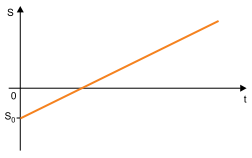
Esse objeto se movimenta com velocidade
No interior de um triângulo ABC estão quatro retângulos. As bases desses retângulos têm a mesma medida e estão sobre o lado AB; o lado BC passa pelos vértices dos retângulos; o retângulo de maior área tem A como um de seus vértices e o retângulo de menor área é um quadrado, conforme mostra a figura, a qual também indica que um lado de um retângulo de menor área está sobre um lado de um retângulo de maior área.
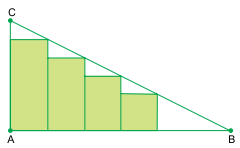
Sabendo que a razão entre a medida do lado AC e a medida
do lado do quadrado é igual a 3 e que a soma das áreas dos
quatro retângulos é igual a 1372 cm2
, a área do triângulo
ABC é
Sobre uma circunferência de centro A e raio 5 cm estão os vértices B e C de um triângulo ABC. O ponto M é médio do lado BC e β = MÂC, conforme mostra a figura.
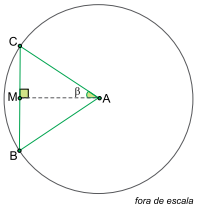
Sabendo que sen β + cos β = 1,2, a área do triângulo ABC é
Considere os números reais x e z tais que 3x = 4z e 2 · 8z = 9x .
O valor de z é
O gráfico de uma função quadrática f(x) = x2 + 2x + 4 tem concavidade voltada para cima e vértice no ponto (–1, 3) e o gráfico da função composta g(f(x)) representa a reflexão do gráfico de f em torno da reta y = 3.
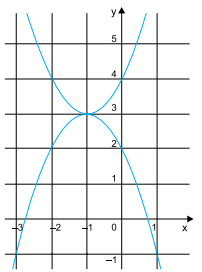
A função g é dada por
Os vértices B e C de um quadrado BCDE estão sobre a reta AC cuja equação é x – 2y – 6 = 0, sendo A e C pontos sobre os eixos coordenados, conforme mostra a figura.
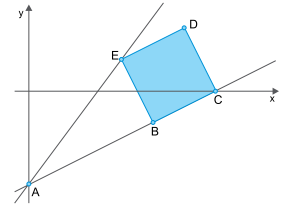
Se a área do quadrado é 5, a equação da reta AE é
Uma rede de papelarias é formada por 3 lojas, nomeadas
loja 1, loja 2 e loja 3. Costumeiramente, essas papelarias
enviam itens de uma loja para outra e o controle desses envios
se dá por meio de uma matriz D = (dij) de ordem 3, em que o
valor da entrada dij indica o número de itens que a loja i enviou
para a loja j. Em um determinado dia, a matriz de controle
de envios foi  . Nos 3 dias seguintes, a loja 1
enviou, a cada dia, 11 itens para cada uma das lojas 2 e 3, a
loja 2 enviou, no total desses 3 dias, 15 itens para a loja 3, e
nenhum outro envio foi feito. Seja C a matriz que é a soma das
matrizes de controle desses 4 dias, seja Ct
a matriz transposta
de C e seja S = C – Ct
. As entradas sij da matriz S assim definida indicam o saldo de itens que a loja i tem com a loja j no
período considerado e uma entrada negativa nessa matriz
indica que a loja recebeu mais itens do que enviou. Os saldos
s12, s23 e s31 são, respectivamente,
. Nos 3 dias seguintes, a loja 1
enviou, a cada dia, 11 itens para cada uma das lojas 2 e 3, a
loja 2 enviou, no total desses 3 dias, 15 itens para a loja 3, e
nenhum outro envio foi feito. Seja C a matriz que é a soma das
matrizes de controle desses 4 dias, seja Ct
a matriz transposta
de C e seja S = C – Ct
. As entradas sij da matriz S assim definida indicam o saldo de itens que a loja i tem com a loja j no
período considerado e uma entrada negativa nessa matriz
indica que a loja recebeu mais itens do que enviou. Os saldos
s12, s23 e s31 são, respectivamente,
Uma pesquisa foi realizada com um grupo de pessoas cujas idades, em anos, pertencem ao conjunto {21, 22, 23, 24, 25, 26}. O gráfico registra as frequências absolutas dos entrevistados com menos de 26 anos.
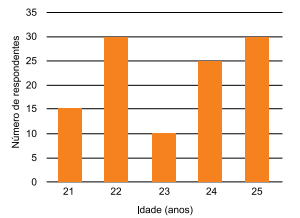
Sabendo que a mediana das idades do conjunto completo de
dados (incluindo as pessoas com 26 anos) é igual a 24 anos,
o número máximo de pessoas com 26 anos que participaram
da pesquisa foi
Considere os afixos dos sete números complexos indicados no plano de Argand-Gauss.

Dado Z= 2√2 (cos 7π/4 + i ˑ sen 7π/4), o afixo do número complexo W Y + Z é
Leia a tirinha Pickles de Brian Crane.
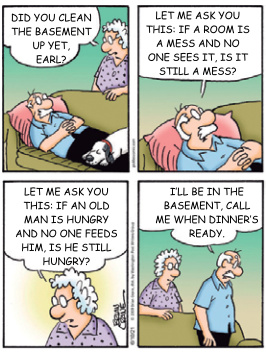
(www.gocomics.com)
A leitura dos dois últimos quadrinhos da tirinha permite inferir que a mulher é uma pessoa
Leia o texto para responder à questão.
While plastic refuse littering beaches and oceans draws high-profile attention, the Food and Agriculture Organization’s (FAO) Assessment of agricultural plastics and their sustainability: a call for action suggests that the land we use to grow our food is contaminated with even larger quantities of plastic pollutants. “Soils are one of the main receptors of agricultural plastics and are known to contain larger quantities of microplastics than oceans”, FAO Deputy Director-General Maria Helena Semedo said in the report’s foreword.
According to data collated by FAO experts, agricultural value chains each year use 12.5 million tonnes of plastic products while another 37.3 million are used in food packaging. Crop production and livestock accounted for 10.2 million tonnes per year collectively, followed by fisheries and aquaculture with 2.1 million, and forestry with 0.2 million tonnes. Asia was estimated to be the largest user of plastics in agricultural production, accounting for almost half of global usage. Moreover, without viable alternatives, plastic demand in agriculture is only set to increase. As the demand for agricultural plastic continues surge, Ms. Semedo underscored the need to better monitor the quantities that “leak into the environment from agriculture”.
Since their widespread introduction in the 1950s, plastics have become ubiquitous. In agriculture, plastic products greatly help productivity, such as in covering soil to reduce weeds; nets to protect and boost plant growth, extend cropping seasons and increase yields; and tree guards, which protect young plants and trees from animals and help provide a growth-enhancing microclimate. However, of the estimated 6.3 billion tonnes of plastics produced before 2015, almost 80 per cent had never been properly disposed of. While the effects of large plastic items on marine fauna have been well documented, the impacts unleashed during their disintegration potentially affect entire ecosystems.
(https://news.un.org, 07.12.2021. Adaptado.)
Leia o texto para responder à questão.
While plastic refuse littering beaches and oceans draws high-profile attention, the Food and Agriculture Organization’s (FAO) Assessment of agricultural plastics and their sustainability: a call for action suggests that the land we use to grow our food is contaminated with even larger quantities of plastic pollutants. “Soils are one of the main receptors of agricultural plastics and are known to contain larger quantities of microplastics than oceans”, FAO Deputy Director-General Maria Helena Semedo said in the report’s foreword.
According to data collated by FAO experts, agricultural value chains each year use 12.5 million tonnes of plastic products while another 37.3 million are used in food packaging. Crop production and livestock accounted for 10.2 million tonnes per year collectively, followed by fisheries and aquaculture with 2.1 million, and forestry with 0.2 million tonnes. Asia was estimated to be the largest user of plastics in agricultural production, accounting for almost half of global usage. Moreover, without viable alternatives, plastic demand in agriculture is only set to increase. As the demand for agricultural plastic continues surge, Ms. Semedo underscored the need to better monitor the quantities that “leak into the environment from agriculture”.
Since their widespread introduction in the 1950s, plastics have become ubiquitous. In agriculture, plastic products greatly help productivity, such as in covering soil to reduce weeds; nets to protect and boost plant growth, extend cropping seasons and increase yields; and tree guards, which protect young plants and trees from animals and help provide a growth-enhancing microclimate. However, of the estimated 6.3 billion tonnes of plastics produced before 2015, almost 80 per cent had never been properly disposed of. While the effects of large plastic items on marine fauna have been well documented, the impacts unleashed during their disintegration potentially affect entire ecosystems.
(https://news.un.org, 07.12.2021. Adaptado.)
Leia o texto para responder à questão.
While plastic refuse littering beaches and oceans draws high-profile attention, the Food and Agriculture Organization’s (FAO) Assessment of agricultural plastics and their sustainability: a call for action suggests that the land we use to grow our food is contaminated with even larger quantities of plastic pollutants. “Soils are one of the main receptors of agricultural plastics and are known to contain larger quantities of microplastics than oceans”, FAO Deputy Director-General Maria Helena Semedo said in the report’s foreword.
According to data collated by FAO experts, agricultural value chains each year use 12.5 million tonnes of plastic products while another 37.3 million are used in food packaging. Crop production and livestock accounted for 10.2 million tonnes per year collectively, followed by fisheries and aquaculture with 2.1 million, and forestry with 0.2 million tonnes. Asia was estimated to be the largest user of plastics in agricultural production, accounting for almost half of global usage. Moreover, without viable alternatives, plastic demand in agriculture is only set to increase. As the demand for agricultural plastic continues surge, Ms. Semedo underscored the need to better monitor the quantities that “leak into the environment from agriculture”.
Since their widespread introduction in the 1950s, plastics have become ubiquitous. In agriculture, plastic products greatly help productivity, such as in covering soil to reduce weeds; nets to protect and boost plant growth, extend cropping seasons and increase yields; and tree guards, which protect young plants and trees from animals and help provide a growth-enhancing microclimate. However, of the estimated 6.3 billion tonnes of plastics produced before 2015, almost 80 per cent had never been properly disposed of. While the effects of large plastic items on marine fauna have been well documented, the impacts unleashed during their disintegration potentially affect entire ecosystems.
(https://news.un.org, 07.12.2021. Adaptado.)
Leia o texto para responder à questão.
While plastic refuse littering beaches and oceans draws high-profile attention, the Food and Agriculture Organization’s (FAO) Assessment of agricultural plastics and their sustainability: a call for action suggests that the land we use to grow our food is contaminated with even larger quantities of plastic pollutants. “Soils are one of the main receptors of agricultural plastics and are known to contain larger quantities of microplastics than oceans”, FAO Deputy Director-General Maria Helena Semedo said in the report’s foreword.
According to data collated by FAO experts, agricultural value chains each year use 12.5 million tonnes of plastic products while another 37.3 million are used in food packaging. Crop production and livestock accounted for 10.2 million tonnes per year collectively, followed by fisheries and aquaculture with 2.1 million, and forestry with 0.2 million tonnes. Asia was estimated to be the largest user of plastics in agricultural production, accounting for almost half of global usage. Moreover, without viable alternatives, plastic demand in agriculture is only set to increase. As the demand for agricultural plastic continues surge, Ms. Semedo underscored the need to better monitor the quantities that “leak into the environment from agriculture”.
Since their widespread introduction in the 1950s, plastics have become ubiquitous. In agriculture, plastic products greatly help productivity, such as in covering soil to reduce weeds; nets to protect and boost plant growth, extend cropping seasons and increase yields; and tree guards, which protect young plants and trees from animals and help provide a growth-enhancing microclimate. However, of the estimated 6.3 billion tonnes of plastics produced before 2015, almost 80 per cent had never been properly disposed of. While the effects of large plastic items on marine fauna have been well documented, the impacts unleashed during their disintegration potentially affect entire ecosystems.
(https://news.un.org, 07.12.2021. Adaptado.)
Leia o texto para responder à questão.
While plastic refuse littering beaches and oceans draws high-profile attention, the Food and Agriculture Organization’s (FAO) Assessment of agricultural plastics and their sustainability: a call for action suggests that the land we use to grow our food is contaminated with even larger quantities of plastic pollutants. “Soils are one of the main receptors of agricultural plastics and are known to contain larger quantities of microplastics than oceans”, FAO Deputy Director-General Maria Helena Semedo said in the report’s foreword.
According to data collated by FAO experts, agricultural value chains each year use 12.5 million tonnes of plastic products while another 37.3 million are used in food packaging. Crop production and livestock accounted for 10.2 million tonnes per year collectively, followed by fisheries and aquaculture with 2.1 million, and forestry with 0.2 million tonnes. Asia was estimated to be the largest user of plastics in agricultural production, accounting for almost half of global usage. Moreover, without viable alternatives, plastic demand in agriculture is only set to increase. As the demand for agricultural plastic continues surge, Ms. Semedo underscored the need to better monitor the quantities that “leak into the environment from agriculture”.
Since their widespread introduction in the 1950s, plastics have become ubiquitous. In agriculture, plastic products greatly help productivity, such as in covering soil to reduce weeds; nets to protect and boost plant growth, extend cropping seasons and increase yields; and tree guards, which protect young plants and trees from animals and help provide a growth-enhancing microclimate. However, of the estimated 6.3 billion tonnes of plastics produced before 2015, almost 80 per cent had never been properly disposed of. While the effects of large plastic items on marine fauna have been well documented, the impacts unleashed during their disintegration potentially affect entire ecosystems.
(https://news.un.org, 07.12.2021. Adaptado.)
Leia o poema “Adeus, meus sonhos!”, do poeta Álvares de Azevedo, para responder à questão.
Adeus, meus sonhos, eu pranteio e morro!
Não levo da existência uma saudade!
E tanta vida que meu peito enchia
Morreu na minha triste mocidade!
Misérrimo! votei meus pobres dias
À sina doida de um amor sem fruto…
E minh’alma na treva agora dorme
Como um olhar que a morte envolve em luto.
Que me resta, meu Deus?!… morra comigo
A estrela de meus cândidos amores,
Já que não levo no meu peito morto
Um punhado sequer de murchas flores!
(Lira dos vinte anos, 1996.)
“Que me resta, meu Deus?!… morra comigo
A estrela de meus cândidos amores,
Já que não levo no meu peito morto
Um punhado sequer de murchas flores!”
A expressão sublinhada pode ser substituída, sem prejuízo para o sentido do verso, por: